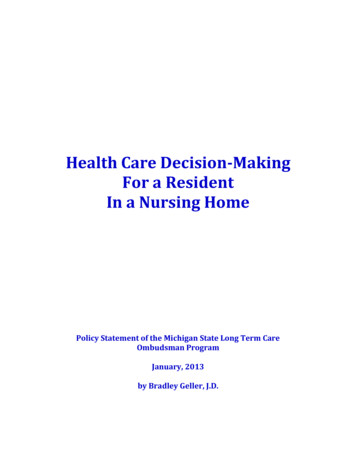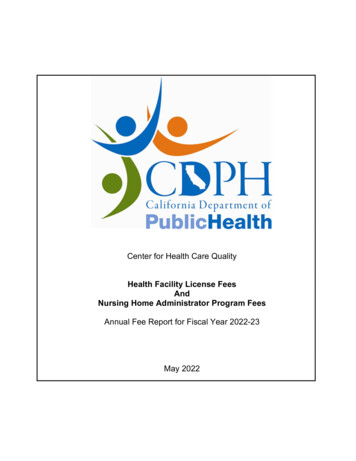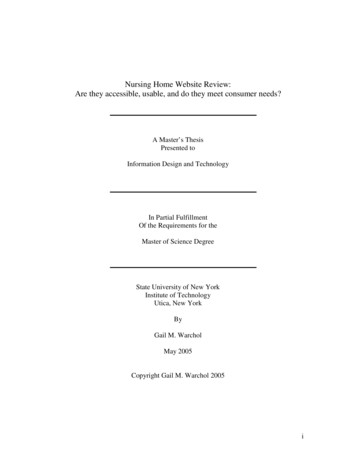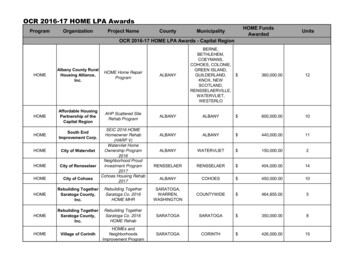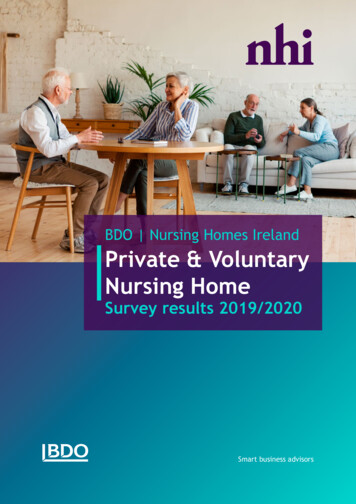
Transcription
BDO Nursing Homes IrelandPrivate & VoluntaryNursing HomeSurvey results 2019/2020Smart business advisors
Contents1 Introduction and Forewords . . . . . . . . . . . . . . . . . . . . . . . . . . . . . 22 Nursing Homes Ireland . . . . . . . . . . . . . . . . . . . . . . . . . . . . . . . . . 83 Presentation of Survey Results . . . . . . . . . . . . . . . . . . . . . . . . . . . 144 Key Sector Indicators . . . . . . . . . . . . . . . . . . . . . . . . . . . . . . . . 155 Private Nursing Home Beds – Current Supply & Growth Outlook . . . . . 166 Private Nursing Home Beds – Prospective Demand . . . . . . . . . . . . . . 227 Profile of Facilities . . . . . . . . . . . . . . . . . . . . . . . . . . . . . . . . . . 248 Profile of Services Available . . . . . . . . . . . . . . . . . . . . . . . . . . . . 269 Profile of Residents . . . . . . . . . . . . . . . . . . . . . . . . . . . . . . . . . . 2910Occupancy Levels . . . . . . . . . . . . . . . . . . . . . . . . . . . . . . . . . . . 3111Weekly Fair Deal Rates . . . . . . . . . . . . . . . . . . . . . . . . . . . . . . . . 3312Financial Performance . . . . . . . . . . . . . . . . . . . . . . . . . . . . . . . . 3913Staffing Matters . . . . . . . . . . . . . . . . . . . . . . . . . . . . . . . . . . . . 4014Food Costs . . . . . . . . . . . . . . . . . . . . . . . . . . . . . . . . . . . . . . . . 4415Other Expenditure . . . . . . . . . . . . . . . . . . . . . . . . . . . . . . . . . . . 4516Summary Schedule by Size . . . . . . . . . . . . . . . . . . . . . . . . . . . . . 4617Area Summaries . . . . . . . . . . . . . . . . . . . . . . . . . . . . . . . . . . . . 4718Appendix: Nursing Home Directory . . . . . . . . . . . . . . . . . . . . . . . . 55Private & Voluntary Nursing Home Survey Results 2019/2020Nursing Homes IrelandBDO
21Introduction and Forewords1.1 Introduction & HighlightsBDO in Ireland (BDO) and Nursing Homes Ireland (NHI) are pleased to present our report onthe Annual Private & Voluntary Nursing Home Survey 2020 (“survey”).The survey was undertaken in early 2020, when a detailed questionnaire was sent toevery registered private and voluntary nursing home in the country. Responses werereceived from 126 nursing homes, which equates to a 28% response rate. The response ratehas provided a sample which is considered to be an appropriate representation of theoverall population being examined.Where reference is made to a finding for the 2019/2020 survey, the period beingreferred to is the financial year ended 2019.The primary purpose of the survey is to report comprehensively on the state of the privateand voluntary nursing home sector in Ireland, to analyse key sector indicators and trendsand to report on matters of concern to nursing home operators.Some key findings of the 2019/2020 survey are outlined below. Comparisons with the2014/2015 survey are outlined where appropriate (the annual survey was not conducted inthe intervening years). Supply of beds – As of September 2020, there are 453 private and voluntaryhomes providing a total of 26,221 beds. There has been an 17.4% increase in thesupply of private and voluntary beds since 2014. Population per private bed – Nationally, at the time of writing this report, there isone private nursing home bed for every 27.5 persons aged 65 and over in theRepublic of Ireland. Occupancy – National average occupancy amongst survey respondents was 90.97%during the year 2019. This represented an increase of 0.52% when compared to 2014.The survey responses were received pre Covid 19 and the occupancy levels reflectthat. The Covid 19 pandemic has had a negative effect on occupancy for much of theremainder of 2020. Weekly Nursing Home Support Scheme (Fair Deal) rates – The average weekly ratenationally, as at October 2020, prevailing under the Fair Deal Scheme foraccommodation in private and voluntary nursing homes, was 1012. The rates arenegotiated by the National Treatment Purchase Fund (NTPF) on behalf of the HealthService Executive (HSE). Staff costs – Staff costs per registered bed accounted for 60% on average of turnoverin respondents’ homes. The national average staff cost per registered bed was foundto be 33,514. This represents a c.24% increase since 2014, previously 27,130. Dependency levels – Dependency levels in nursing homes continue to be very high.Since the introduction of the medical needs assessment, persons going into nursinghomes are more dependent and require more complex care. The number of nursinghome residents presenting with evidence of dementia continues to rise. Therespondents to our survey reported that approximately half of residents have beenclinically diagnosed with dementia.Private & Voluntary Nursing Home Survey Results 2019/20202Nursing Homes IrelandBDO
3Average Weekly Fair Deal rate as at October 2020CountyPrivate & Voluntary2020 Co. Carlow939Co. Cavan975Co. Clare910Co. Cork1,014Co. Donegal904Co. Dublin1,200Co. Galway916Co. Kerry916Co. Kildare1,074Co. Kilkenny963Co. Laois980Co. Leitrim940Co. Limerick922Co. Longford947Co. Louth1,024Co. Mayo921Co. Meath1,035Co. Monaghan980Co. Offaly925Co. Roscommon910Co. Sligo1,023Co. Tipperary919Co. Waterford978Co. Westmeath914Co. Wexford929Co. Wicklow1,076National Average1,012Private & Voluntary Nursing Home Survey Results 2019/20203Nursing Homes IrelandBDO
41.2 Foreword by Tadgh Daly, Chief Executive Officer, Nursing Home IrelandThis report is published against a backdrop of sustained national focus on the nursing homesector.It is imperative lessons are learned from Covid 19 and this report provides a comprehensiveoverview regarding the footprint of the sector nationally and within every county acrossIreland.It is a positive that we are living longer. This achievement manifests in an increasedrequirement for a range of care services, particularly nursing home care.This research finds over half of people in our nursing homes are over 85 years of age andthis cohort of the population will grow by a factor of four in the next 30 years. The careprovided by nursing homes is highly specialised and will require bed capacity and anappropriate staffing skill-mix to provide such.The research presents an inherent anomaly in the funding of nursing home care. Staffingcosts have increased by 23.5% since 2014, with 60% of nursing home turnover accountablefor staffing costs. Yet, over the same period, the increase in fees payable under theNursing Home Support Scheme (Fair Deal) is 13.3%.The inherent non-confidence within the sector in how the NTPF fulfils its role is appraised,with c.93% of the nursing home respondents stating it fails to recognise the reality ofcosts incurred to provide high-dependency, person-focussed, specialised care in thenegotiation process.BDO reports the NTPF has been providing Fair Deal rate increases of slightly in excess of2% per annum, largely leading to the preservation of operating margins but excludingfunding towards capital repayments. This leading to a trend of operators entering into saleand leaseback structures and redeeming their bank debt in the process.This analysis follows Comptroller and Auditor General examination of Fair Deal, publishedAugust 2020 and undertaken over a two-year period, finding the body responsible fornegotiation of fees on behalf of the State, the NTPF, does not have in place a model toprovide evidential proof for how it sets fees.The State has acknowledged nursing home fees are not commensurate with the reality ofcosts incurred for people requiring the specialised, round-the-clock care provided by nursinghomes. Yet this crisis within our health services has not been addressed by successiveGovernments. Covid 19 focussed attention on the nursing home sector and presents impetusto address the discriminatory practice that exists in the funding of nursing home residentsunder Fair Deal.This is played out against a backdrop of increased growth in requirement occurring fornursing home care. NHI commissioned research undertaken by the Centre for Health Policyand Management, Trinity College Dublin informs the reality that the considerable increasein our older population in the short - to medium-term will result in increasing numbersneeding the specialised clinical, health and social care provided by nursing homes on around-the-clock basis.Population estimates from the CSO would suggest that the rise in demand will not be evenlydisbursed across the country, yet BDO’s analysis informs development of nursing homes inmost counties outside of Dublin is sometimes seen as unviable and smaller nursing homesare closing due to financial unviability. Contrary to perception, there has been aconsiderable slowdown in the provision of new bed capacity within the sector, with onlyPrivate & Voluntary Nursing Home Survey Results 2019/20204Nursing Homes IrelandBDO
5modest actual growth in bed numbers over the six-year period 2014 to 2020. Over 5,000beds have been granted permission but not developed the report informs, with the financialviability of new builds a key barrier.A health and social emergency of gross magnitude will present if reform of the funding ofnursing home care is not addressed as a priority. The Covid 19 Nursing Homes Expert Panelstate requirement for enhanced integration of nursing home care into our health services.This report provides an evidential basis to assess the private and voluntary nursing homesector in Ireland and inherent challenges presenting with regard to staffing and funding.The recent concentration on the sector must combine with a State-led focus on the necessityto place it on a sustainable footing for present and future generations that will requirenursing home care.Thank you to all our members who participated in informing this important researchreport and to BDO for compiling it.Private & Voluntary Nursing Home Survey Results 2019/20205Nursing Homes IrelandBDO
61.3 Foreword by Brian McEnery, Partner & Head of Advisory, BDOThe private and voluntary nursing home sector is changing rapidly and at a pace which hasnot been observed since BDO commenced its sectoral analysis in 2003.It is important, at the outset, to acknowledge the ground that has been made. In 2003 therewere 14,946 beds in 408 nursing homes; but in 2020 there were 26,221 - an increase ofslightly over 75% in the number of beds in that 17-year period. However, the increase inregistered nursing homes has been only 11%, with the average size of nursing homesincreasing from 37 beds to 58 beds.Some important provisions of the Care and Welfare of Residents in Designated Centres forOlder People Regulations, which were amended in 2016, are scheduled to come into effectin January 2022. These Regulations apply to the public, as well as the private and voluntarysectors, and are intended to ensure quality in the provision of accommodation to residentsof nursing homes, through minimum size of bedrooms as well as measures toimprove infection control through the reduction in numbers of residents beingaccommodated in shared and multiple occupancy bedrooms.The need for the implementation of these regulations, particularly surrounding singleoccupancy bedrooms, looks particularly relevant as we reflect on the difficult experiencesof Covid 19. Rigorous implementation of the regulations will likely impact supply and capitalexpenditure in the private and voluntary sector. Our survey indicates that 77% ofaccommodation in the private and voluntary sector is in the form of single bedrooms, whilethe HIQA standards for new centers requires at least 80% of supply to be single en-suiterooms. Therefore, it largely appears that the private and voluntary sector will meetthe physical environment requirements set by HIQA. The challenge, however, will provemuch greater for the public sector as the stock of long-term care facilities is older andhas seen less investment than the private and voluntary sector in recent times. In anumber of instances around the country, the HSE have been reducing the number ofresidents that are accommodated in public facilities, so the ratio of residents is more incompliance with the regulations. HIQA has indicated a desire to move towardscontinuous and responsive improvement, as opposed to periodically implementingsector wide standards and regulations that flow from those standards. Theexperience of Covid 19 has undoubtedly driven HIQA’s desire for responsive improvementto ensure resident welfare.Another key finding from our report is the large variation in Fair Deal rates across thecountry and, while certain costs are higher on the East Coast (particularly Dublin), thedifference between the highest county average (Dublin at 1,200 per resident per week)and the lowest county average (Donegal at 904 per resident per week) is 296 per residentper week. In effect, the Donegal home receives one third less than its peers in Dublin. In anumber of locations around Ireland, it is not economically viable to develop new nursinghomes on the Fair Deal rates which are granted to new facilities. With building costs as theyare, it is difficult to see a home with c. 50m2 per resident being feasible for a Fair Deal rateof 1,000 per resident per week or less. The need for investment in the nursing home stock,in regions with lower Fair Deal rates, is validated by the report finding that the North Westof Ireland has the highest population of over 65’s per nursing home bed (43.9 persons perbed) with Dublin, Kildare & Wicklow the lowest (24.2 persons per bed).The cost of developing a nursing home bed has a range of between 150,000 and 200,000and this level of investment significantly reduces the potential for traditional ownershipstructures to prevail into the future. For this very reason, large specialist operators withsignificant capital capabilities are growing their market share in comparison to the owneroperator and voluntary cohorts that really sustained the sector here in the past. BDO seesthis trend continuing.Private & Voluntary Nursing Home Survey Results 2019/20206Nursing Homes IrelandBDO
7In addition, we expect that there will be a continuing reduction of nursing home beds inhomes with less than 40 beds. Approximately 29% of beds are currently in smaller homes,but this is down from 35% in the 2014 survey and down from 64% in 2003. Overall, nursinghomes are getting bigger, the investment required to develop them is larger and thesmaller, older homes are falling out of the sector. This is why there has been a 75%increase in bed supply, with only an 11% increase in the number of nursing homes.In summary, this BDO report validates the strides made in the sector over the past twodecades; but sets out some challenges ahead that will require significant investmentto resolve.Finally, I would like to gratefully acknowledge the time nursing home operators have takento complete the detailed questionnaire which we sent to them so this survey couldbe compiled.Private & Voluntary Nursing Home Survey Results 2019/20207Nursing Homes IrelandBDO
82Nursing Homes Ireland2.1 ProfileNursing Homes Ireland (NHI) is the representative organisation for the private and voluntarynursing homes sector. The sector, and the care our members provide, are central tohealthcare delivery in Ireland. Private and voluntary nursing homes: Provide 26,221 beds; Account for more than 80% of all long-term care beds in the country; and Provide direct employment to more than 36,000 staff.NHI members account for 90% of all private and voluntary nursing homes.NHI actively supports members, enabling them to provide sustainable, high quality care toresidents. The fulfilment of NHI’s role in the sector in this regard is underpinned by its corevalues: Empower: We empower members with up-to-date information and guidance. Influence: We influence policy decisions, using up-to-date evidence and advocacy. Lead: We provide leadership for the sector. Promote: We promote a positive image of the sector and the important role nursinghomes play in the provision of health care and social care. Partner: We partner with all our key stakeholders to support the delivery of care.2.2 Our Vision for the FutureAs a nation, Ireland still has the resources to develop the best possible services to meet theneeds of a growing older population.Our vision is for a strong, sustainable and agile private and voluntary nursing home sector,as a vital part of Ireland’s health care system. To achieve this, NHI will continue to advocateon behalf of our members and the sector and will strengthen our range of professionalservices provided to members.We in NHI have a significant contribution to make in developing those services, so thatresidential care for our older people is the best that it can be. Nursing homes fulfilGovernment objective of delivering high quality, person-centred care in the community. Wehave the expertise, the commitment and the willingness to work alongside the Governmentand all other key stakeholders in the sector to ensure long-term residential care is meetingthe increasingly complex care requirements of persons moving to nursing homes.Our expertise and our ideas are of key importance in informing the development of publicpolicy on the care of older people. We are advancing and promoting this important debate,as key providers of a vital part of the health service and seeking the appropriate supportframework to meet the challenges of growing and funding the best possible services for ourolder people.NHI’s vision is to lead and shape the environment in which care services provided by ourMembers achieve the highest quality of life for the residents in their care. It is one we arecontinuously advancing through meaningful partnership and consistent engagement with theGovernment, the HSE and the NTPF as purchasers, the Health Information and QualityAuthority (HIQA) as the regulator, our members and all the stakeholders.Private & Voluntary Nursing Home Survey Results 2019/20208Nursing Homes IrelandBDO
9Having high quality care available to those who need it is an essential part of a wellfunctioning health service which delivers the care people need, in a way that is affordable,accessible, and, of the highest standard. Those who use our services should have the choiceand flexibility in selecting the nursing home that most suits their needs.2.3 Commitment of MembersNHI members are committed to: Maintaining and enhancing the quality of life of residents Preserving the autonomy of residents, guaranteeing free expression of opinion andfreedom of choice Maintaining a safe physical environment and caring for the emotional wellbeing ofresidents Ensuring that the privacy and dignity of residents is respected Being an employer of choice and providing continuous professional development andtrainingEnsuring High StandardsAt NHI, the resident is always at the heart of what we do. We support private and voluntarynursing homes to deliver the very highest standard of care. Nursing homes are specialisedclinical, health and social care settings. The care is provided on a 24/7 basis withindedicated ‘home from home’ health settings.We care about the delivery of better care. We support our members to create richexperiences of life for residents. Our members meet residents where they are on theirjourney and focus on enriching lives well-lived.Care is better when we work together. We empower our private and voluntary nursing homemembers with the latest information and advocate for the sector so it can perform better.We bring our message of warmth, comfort and responsibility in a clear and strong voice tothe wider community.We are working to shape a new, more dynamic model of care. Caring is best when it iscollective and collaborative. With our residents, members, communities and stakeholders,we are confidently moving forward together.Meeting the True Cost of CareNHI is advancing the critical requirement for an enhanced framework that recognises andsupports the increasingly complex care requirements of nursing home residents. The privateand voluntary nursing home sector must be provided with certainty and a funding frameworkthat ensures it is in a position to plan and invest in meeting the increasing residential careneeds of our ageing population.Nursing home care fulfils an essential role in healthcare provision in Ireland and in ensuringwe treat our older people with respect and dignity. It is fundamentally important for theState to ensure the funding of nursing home care realistically reflects the growth inrequirement for this specialist care and the high dependency and high complexity care needsof persons requiring it.There is requirement for an enhanced evidence-based cost-of-care funding model to ensurethe specialised care needs of those requiring long-term residential care are addressed.Private & Voluntary Nursing Home Survey Results 2019/20209Nursing Homes IrelandBDO
10An enhanced model to support residents in long-term residential care must recognisethe increased dependency and complex care needs of residents in such care.Persons availing of nursing home care have high-dependency, high complexity, multiplecomorbidity care needs. They present with severe physical and cognitive impairment,requiring 24/7 person-focussed clinical, health and social care.Management & GovernanceNHI represents the interests of its members and the nursing home sector through aneffective, democratic governance structure. As the national representative organisation forthe private and voluntary nursing home sector, NHI is organised through 10 regionalcommittees, with governance provided by a 12 member Board of Directors.The NHI governance structure affords all members membership of one of ten regionalcommittees; each region elects a representative to the Board of Directors.The 12 member Board, elected annually, consists of the 10 elected regional committeerepresentatives, a national nursing committee representative and a non-executiveindependent chairman who is appointed by the Board.The organisation is structured so that members are encouraged and assisted to play an activepart in its deliberations and its decision-making processes.The regions also elects a representative to the National Nursing Committee and aregional chair and regional secretary. Furthermore, each region elects, annually,a regional representative to named subcommittees as specified by the Board ofDirectors. Each of the 10 NHI regions directly elect, at their regional AGM, arepresentative to the following 3 Board subcommittees: Regulatory Affairs, Commercialand Financial Affairs and Public Affairs and Communications.To encourage and facilitate greater involvement of members in the affairs of theorganisation, NHI has established subcommittees of the Board of Directors to assist inmanaging the affairs of the organisation and to ensure that all relevant issues areappropriately addressed.The current NHI board subcommittees are as follows: National nursing committee Finance, risk and audit committee Legal affairs committee Regulatory affairs committee Commercial and financial affairs committee Public affairs and communications committeePrivate & Voluntary Nursing Home Survey Results 2019/202010Nursing Homes IrelandBDO
11NHI RegionAreas CoveredDublin/KildareDublin (West & Southwest), KildareDublin NorthDublin (North)Dublin/WicklowDublin (South & Southeast), WicklowMidlandsLaois, Longford, Offaly, WestmeathMidwestLimerick, Clare, Tipperary (North)North EastCavan, Louth, Meath, MonaghanNorth WestDonegal, Leitrim, SligoSouthCork, KerrySouth EastCarlow, Kilkenny, Tipperary (South), Waterford, WexfordWestGalway, Mayo, Roscommon2.4 Irish Nursing Home Market Analysis NationallyThe private nursing home sector in Ireland is a sector which has evolved significantly in thelast decade. Arising from an increasing older population, the demand for older person carefacilities is growing.The sector has seen the emergence of multi-site home operators who have driven significantinvestment. The sector has seen the entry of international real estate funds through saleand leaseback structures and international nursing home operating company groups. In mostinstances these parties have acquired existing nursing home groups. Approximately 40% ofprivate nursing homes are operated or owned by one type of group or another.Increasingly, nursing homes are modern operations with a greater range of facilities andhave the ability to meet greater care requirements.In Ireland, nursing home care is principally regulated by the following legislation: Health (Nursing Homes) Act 1990 (as amended) Nursing Homes (Care and Welfare) Regulations 1993 The Health Act 2007 (as amended) Care and Welfare Regulations as amended – Health Act 2007 Registration Regulations – Health Act Nursing Homes Support Scheme Act 2009 National Standards for Residential Care Settings for Older People in Ireland 2016 (asamended) S.I. No. 415/2013, - Health Act 2007 (Care and Welfare of Residents in DesignatedCentres for Older People) Regulations 2013 S.I. No. 61/2015, Health Act 2007 (Registration of Designated Centres for OlderPeople) Regulations 2015.Private & Voluntary Nursing Home Survey Results 2019/202011Nursing Homes IrelandBDO
122.5 Ireland’s Ageing Demographic ProfileIreland’s demographic profile is characterised by the continually increasing numbers ofpeople aged 65 and older. The country has experienced strong population growth in the past28 years, during which time it has increased from approximately 3.52 million in 1991 to 4.97million in 2020.The population aged 65 and over is a key demographic when seeking to estimate thenumber of nursing home beds required in a country, due to the increasing medicaldependency of people as they age. The CSO estimated, in 2016, that the 65 populationwould increase to approximately 1.6m people and account for approximately 1 in 4 of thetotal population by 2051.It was estimated that the population aged 65 would grow by: 17% from 2016-2021 145% from 2016-2051In 2016, the population aged 65 and over in Ireland was 637,567; or 13.4% of the totalpopulation and was estimated to increase to approximately 743,066 by 2021. The mostrecent population estimates from CSO, published in August 2020, suggest a total of 720,200people living in Ireland are aged 65 and over (as at April 2020); representing a 13% increaseduring this period. This would suggest that prior estimates of 2016 are trending largely inline with current estimates.Supply & DemandThere are currently 31,909 registered nursing home beds in Ireland; of which 5,688 areoperated by the HSE, with the balance operated by the private and voluntary sector.A key OECD indicator, although not definitive nor to be taken in isolation, is often used toestimate a country’s requirement for nursing home bed spaces and suggests approximately4% to 5% of the population aged 65 and over. The current bed supply equates toapproximately 4.45% of the estimated population over 65 (31,909/720,200). This wouldsuggest that Ireland has adequate supply in the short term to meet demand; albeit weunderstand that this supply is not evenly distributed across the country.Whilst it is subjective and difficult to precisely assess the future requirement of nursinghome beds for people over 65 years old, various research studies have been conducted inthis area in an attempt to identify trends for future demand. One such example is the recentNHI Commissioned study conducted by Trinity College Dublin in 2019, which aimed toaddress the current and future requirements for nursing home care for people over 65 yearsof age in Ireland 1, showing projected demand in nursing home beds by 2031.The research was primarily based on three scenarios namely population growth, healthyageing population and healthy aging; and although the metrics and base scenarios used topredict future bed demand vary materially depending on the approach adopted, eachscenario depicted an outcome of a significant increase in demand for nursing home beds inthe future.Notwithstanding same, it is expected, based upon the current supply demographic inaddition to the projected over 65 population growth (to approximately 1m by 2031), thatthere will be a significant requirement for increased bed capacity into the future.1Projecting-long-term-care-in-Ireland, TCD, NHIPrivate & Voluntary Nursing Home Survey Results 2019/202012Nursing Homes IrelandBDO
13If we were to apply the international indicator of 4-5% as an example, the demand fornursing home bed spaces could potentially reach nearly 45,000 by 2031.Despite the number of nursing home projects in various stages of planning, Fair Deal ratesare currently rendering new nursing home development unviable in most locations outsideof Dublin due to the current cost of construction. It is difficult to see significant newdevelopment commencing in most areas where there will be a significant future need. Thereis also likely to be a reduction in existing nursing home capacity over the coming years asthe 2016 standards (National Standards for Residential Care Settings for Older People inIreland, 2016) are enforced by December 2021. It is expected that many existing homes,particularly smaller homes that are not purpose-built, will struggle to comply with thesestandards and therefore overall capacity will be affected.Private & Voluntary Nursing Home Survey Results 2019/202013Nursing Homes IrelandBDO
143Presentation of Survey Results3.
and voluntary nursing home orsectin Ireland, to analyse key sector indicators and trends and to report on matters of concern to nursing home operators. Some key findings of the 2019/2020 survey are outlined below. Comparisons with the 2014/2015 survey are outlined where appropriate (the annual survey was not conducted in the intervening years).






